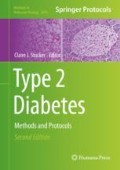Abstract
Islet transplantation is a potential treatment for Type 1 diabetes; however, improvements need to be made before it could become clinically widely available. In preclinical studies, the mouse is often used to model islet transplantation, with most studies aiming to improve transplantation outcome by manipulating the islets prior to transplantation or by treating the recipient mouse. Here, we describe the process of islet transplantation in the mouse, including how one can make the mouse diabetic, isolate donor islets, and transplant the islets into two different sites. Finally, we discuss how to assess the outcome of the transplantation in order to determine whether the experimental intervention has been beneficial.
Access this chapter
Tax calculation will be finalised at checkout
Purchases are for personal use only
References
Bruni A, Gala-Lopez B, Pepper AR, Abualhassan NS, Shapiro AJ (2014) Islet cell transplantation for the treatment of type 1 diabetes: recent advances and future challenges. Diabetes, Metab Syndr Obes 7:211–223
Zhi ZL, Kerby A, King AJ, Jones PM, Pickup JC (2012) Nano-scale encapsulation enhances allograft survival and function of islets transplanted in a mouse model of diabetes. Diabetologia 55:1081–1090
Kerby A, Bohman S, Westberg H, Jones P, King A (2012) Immunoisolation of islets in high guluronic acid barium-alginate microcapsules does not improve graft outcome at the subcutaneous site. Artif Organs 36:564–570
Estil les E, Tellez N, Escoriza J, Montanya E (2012) Increased beta-cell replication and beta-cell mass regeneration in syngeneically transplanted rat islets overexpressing insulin-like growth factor II. Cell Transplant 21:2119–2129
Fernandes JR, Duvivier-Kali VF, Keegan M et al (2004) Transplantation of islets transduced with CTLA4-Ig and TGFbeta using adenovirus and lentivirus vectors. Transpl Immunol 13:191–200
King A, Lock J, Xu G, Bonner-Weir S, Weir GC (2005) Islet transplantation outcomes in mice are better with fresh islets and exendin-4 treatment. Diabetologia 48:2074–2079
McCall M, Toso C, Emamaullee J et al (2011) The caspase inhibitor IDN-6556 (PF3491390) improves marginal mass engraftment after islet transplantation in mice. Surgery 150:48–55
King AJ, Guo Y, Cai D et al (2013) Sustained NF-kappaB activation and inhibition in beta-cells have minimal effects on function and islet transplant outcomes. PLoS One 8:e77452
Toso C, Serre-Beinier V, Emamaullee J et al (2008) The role of macrophage migration inhibitory factor in mouse islet transplantation. Transplantation 86:1361–1369
Rackham CL, Chagastelles PC, Nardi NB, Hauge-Evans AC, Jones PM, King AJ (2011) Co-transplantation of mesenchymal stem cells maintains islet organisation and morphology in mice. Diabetologia 54:1127–1135
Pawlick R, Gala-Lopez B, Pepper AR, McCall M, Ziff O, Shapiro AM (2014) The combination of anti-NKG2D and CTLA-4 Ig therapy prolongs islet allograft survival in a murine model. Am J Transplant 14:2367–2374
Bohman S, Andersson A, King A (2006) No differences in efficacy between noncultured and cultured islets in reducing hyperglycemia in a nonvascularized islet graft model. Diabetes Technol Ther 8:536–545
Deeds MC, Anderson JM, Armstrong AS et al (2011) Single dose streptozotocin-induced diabetes: considerations for study design in islet transplantation models. Lab Anim 45:131–140
King A, Bowe J (2016) Animal models for diabetes: understanding the pathogenesis and finding new treatments. Biochem Pharmacol 99:1–10
King AJ, Austin AL, Nandi M, Bowe JE (2016) Diabetes in rats is cured by islet transplantation... but only during daytime. Cell Transplant 26(1):171–172
Mathews CE, Langley SH, Leiter EH (2002) New mouse model to study islet transplantation in insulin-dependent diabetes mellitus. Transplantation 73:1333–1336
Hong J, Yeom HJ, Lee E et al (2013) Islet allograft rejection in sensitized mice is refractory to control by combination therapy of immune-modulating agents. Transpl Immunol 28:86–92
Krautz C, Wolk S, Steffen A et al (2013) Effects of immunosuppression on alpha and beta cell renewal in transplanted mouse islets. Diabetologia 56:1596–1604
Chen X, Zhang X, Chen F, Larson CS, Wang LJ, Kaufman DB (2009) Comparative study of regenerative potential of beta cells from young and aged donor mice using a novel islet transplantation model. Transplantation 88:496–503
Leiter EH, Schile A (2013) Genetic and pharmacologic models for type 1 diabetes. Curr Protoc Mouse Biol 3:9–19
Sakata N, Yoshimatsu G, Tsuchiya H, Egawa S, Unno M (2012) Animal models of diabetes mellitus for islet transplantation. Exp Diabetes Res 2012:256707
McGuinness OP, Ayala JE, Laughlin MR, Wasserman DH (2009) NIH experiment in centralized mouse phenotyping: the Vanderbilt experience and recommendations for evaluating glucose homeostasis in the mouse. Am J Phys Endocrinol Metab 297:E849–E855
Author information
Authors and Affiliations
Corresponding author
Editor information
Editors and Affiliations
Rights and permissions
Copyright information
© 2020 Springer Science+Business Media, LLC, part of Springer Nature
About this protocol
Cite this protocol
King, A.J.F., Rackham, C.L. (2020). Assessing Islet Transplantation Outcome in Mice. In: Stocker, C. (eds) Type 2 Diabetes. Methods in Molecular Biology, vol 2076. Humana, New York, NY. https://doi.org/10.1007/978-1-4939-9882-1_16
Download citation
DOI: https://doi.org/10.1007/978-1-4939-9882-1_16
Published:
Publisher Name: Humana, New York, NY
Print ISBN: 978-1-4939-9880-7
Online ISBN: 978-1-4939-9882-1
eBook Packages: Springer Protocols

